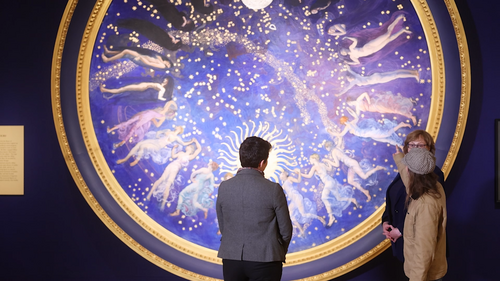
An undergraduate seminar taught by astrophysicist Meg Urry adds an artistic dimension to scientific concepts of time and space.
Islay Ross, who grew up on a small island off the coast of Washington state, learned how to express her feelings with paint, fabric, and collage long before visiting the Yale University Art Gallery as part of a seminar for first-year Yale College students this fall.
She had even exhibited her work in a national art show before graduating from high school.
Yet until she took Meg Urry’s seminar on “Expanding Ideas of Time and Space,” Ross had never peered intently at a piece of art and thought about … Einstein’s general theory of relativity.
“Let’s just say the physics part was unexpected,” Ross says, reflecting on the seminar class visit to the Gallery. “But the more I thought about it, the more I realized it’s all connected — the way we experience art, the way we experience time, the way we create. There’s even music in physics, in the way the Big Bang sent out waves that are sometimes discordant and sometimes in harmony.”
This is music to Urry’s ears.
Urry, the Israel Munson Professor of Physics and Astronomy in Yale’s Faculty of Arts and Sciences and one of the world’s leading astrophysicists, has high expectations for this seminar. She’s taught the class since 2018 and was one of the first science professors to bring students to the Gallery — inspired by a visiting professor of physics, Ágnes Mócsy, who taught a seminar called “Physics Meets the Arts.”
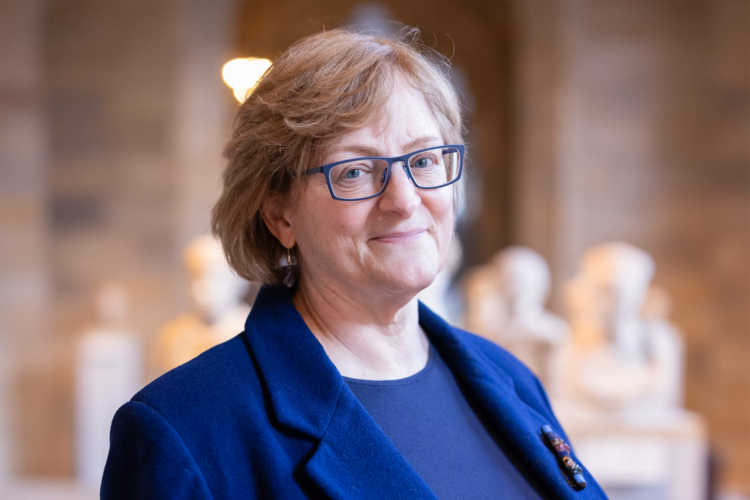
Urry’s class, which is offered to students of all academic backgrounds, conveys basic physics concepts as well as a sense of how science works, how it is funded, and how it benefits humanity. Beyond that, Urry wants “Expanding Ideas of Time and Space” to foster a spirit of connection and belonging among new students as they begin their college experience.
The course always includes an early class visit to the Gallery, where the students muse about time and connect it to the physics they’ve learned.
“It offers a great way to introduce my students to the Gallery, to stimulate the way they think about physics, and to build a community within the class,” Urry says.
A good, long look
Home to a collection of more than 300,000 objects from across the world, from antiquity to the present, the Gallery hosts hundreds of university classes every year. These classes include students from other universities in addition to Yale and cover a wide range of academic disciplines.
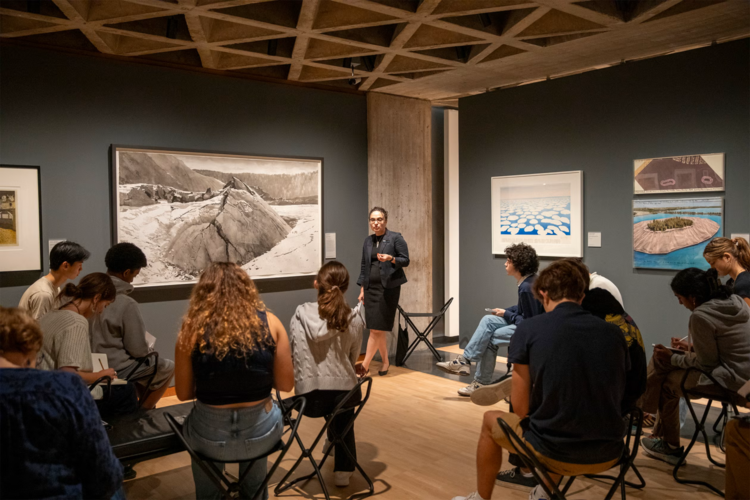
Sydney Skelton Simon, the Bradley Associate Curator of Academic Affairs, oversees university-level curricular engagement at the Gallery. She works with faculty to design and teach many of the interdisciplinary course visits to the museum. Simon and Urry recently co-authored a dialogue about their pedagogical collaboration in a special science-and-art themed edition of the University Museums and Collections Journal, co-edited by Liliana Milkova, the Gallery’s Nolen Curator for Education and Academic Affairs.
“Sydney and Meg’s partnership on this course offers an exciting model for integrating the Gallery in STEM classes at Yale,” Milkova says. “Thoughtfully designed encounters with works in our collection present myriad possibilities for supporting science curricula, whether by making subject-matter connections or aiming at more intangible outcomes such as the cultivation of habits of mind, such as creative writing, that will serve students well in their academic and personal pursuits alike.”
Deep collaborations with faculty members yield educational opportunities to teach with art, rather than about the art, Milkova and Simon note. Students develop a range of skills this way, such as visual analysis, critical thinking, empathy, intellectual curiosity, and clear communication.
For “Expanding Views of Time and Space,” Urry, Simon, and Miriam Ashkin Stanton, the Gallery’s Lewis B. and Dorothy Cullman-Joan Whitney Payson Postdoctoral Fellow in Academic Affairs and Outreach, selected a handful of objects for Urry’s students to view. For university class visits, Gallery educators design and teach the session as guest instructors. Stanton taught the session for Urry’s class visit.
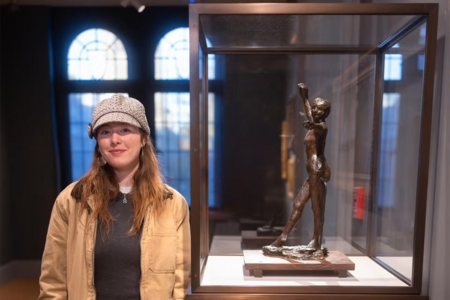 Ross reads a portion of her essay on the Edgar Degas wax and mixed media sculpture “Dancer Ready to Dance with Her Right Foot Forward.”
Ross reads a portion of her essay on the Edgar Degas wax and mixed media sculpture “Dancer Ready to Dance with Her Right Foot Forward.”
Art objects in past years have included a still-life painting by American artist Audrey Flack; an Aztec calendar stone; paintings by British artist John Constable; a Pomo woven basket; and a Japanese kimono.
This year’s class featured items that included Edwin Austin Abbey’s “Study for ‘The Hours;’” Emma Stibbon’s “Broken Tumulus”; a Tang Dynasty tomb sculpture of a Bactrian camel; and Erika Klien’s “Abstraction.”
The students are encouraged to thoroughly observe each artwork before attempting analysis or interpretation. Then they discuss their observations. After the class visit, students are asked to return to the Gallery to select another work to write an essay about how it relates to time and space.
“Our visit to the museum touches something in these students that science classes do not usually reach,” Urry writes in her journal article with Simon. “Their own subjectivity is foregrounded. They analyze without resorting to an explanatory text. There is no right answer, just interesting observations that may or may not be echoed by classmates.
“The museum visit appeals to those for whom physics equations might be a turnoff. It enforces the idea that everyone is welcome in a science class and has valuable ideas to offer. Although I emphasize this with the students from the beginning, I know the museum visit helps the more art-oriented students believe they belong.”
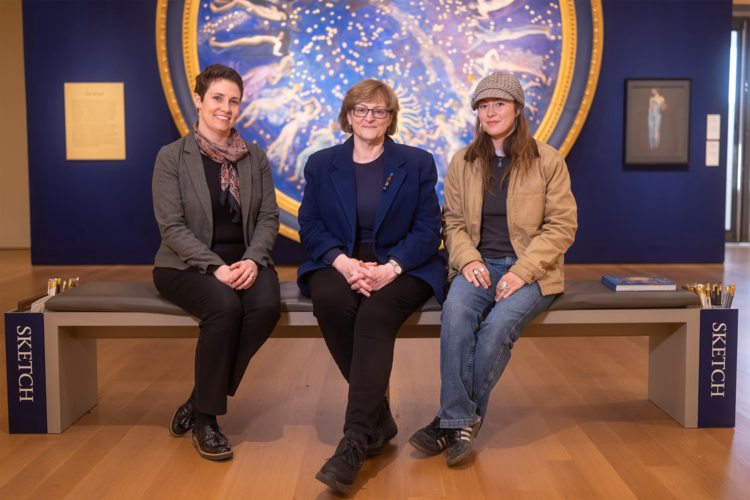
Leaving thumbprints
During a recent return visit to Gallery for a Yale News interview, Urry, Simon, and Ross spent a few moments contemplating a “Study for ‘The Hours,’” which was part of the gallery exhibition “The Dance of Life: Figure and Imagination in American Art, 1876-1917,” which was on view at the Gallery from Sept. 6, 2024 to Jan. 5, 2025. It features a celestial map of the night sky, bordered by human representations of the hours in a day.
“Here are the hours, dancing around the 24 positions of the day,” Urry says. “The Milky Way is in there, too. It connects time, equations, and art.”
Ross reflects on how time slows down in an art gallery, much the way it does when you live on an island and depend on a ferryboat to get most places.
Her favorite piece, the one she wrote about for class, freezes a single moment in time. It is the Edgar Degas wax and mixed media sculpture “Dancer Ready to Dance with Her Right Foot Forward,” depicting a ballerina paused between third and fourth position: right arm raised, left arm straight out, back arched.
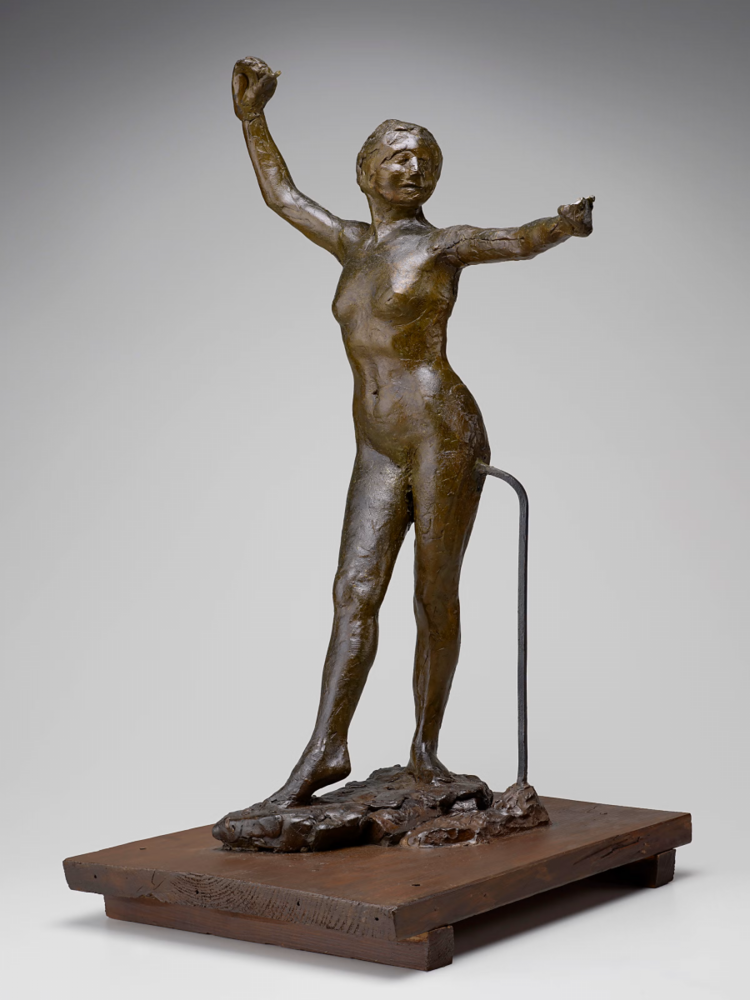
For Ross, the piece speaks to the isolation of an instant and the physics of creating an object that she says defies gravity.
“It’s such a specific moment,” Ross says. “I was also enamored with how Degas captured his own moment, by leaving his thumbprint in the sculpture.”
In a different part of the Gallery, the group meets up with another member of Urry’s class, first-year student Alan Zhong.
Zhong is from Baskin Ridge, New Jersey, and says his interest in science is enlivened by his interest in music and creative writing. His essay topic, the Wangechi Mutu sculpture “Sentinel I,” stands in the middle of the room.
It’s a figure of a woman, made of organic materials such as wood, pulp, and shells. Zhong says it looks like a guardian of time itself — aging and evolving, but ever vigilant.
“It has a commanding presence,” Zhong explains. “I was drawn to it pretty quickly. I remember I was in a stressful place the day we visited. Coming to the Gallery felt comforting and I was glad I had time set aside to take this in.”
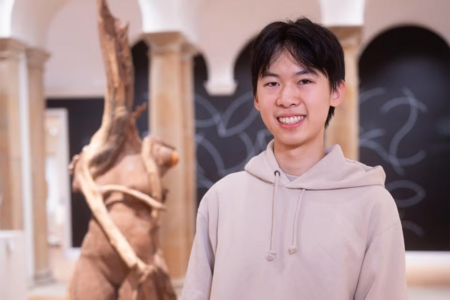 First-year student Alan Zhong reads a portion of his essay on the Wangechui Matu sculpture “Sentinel I.”
First-year student Alan Zhong reads a portion of his essay on the Wangechui Matu sculpture “Sentinel I.”
Urry tells him that is one of the aims of the class. “We want you to stop and ask yourself how these objects came to be — and bring that same curiosity with you into the world.”
As the group makes its way around the room, pausing at different pieces for discussion, Simon hangs back and offers a knowing smile.
“The secret to this class is that everything in the museum is about time,” she says.
This story was adapted from the Yale News story of January 10, 2025 by Jim Shelton. Video and audio clips referred to above are available in the original story which is linked below.